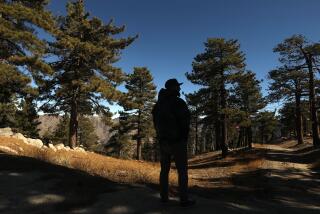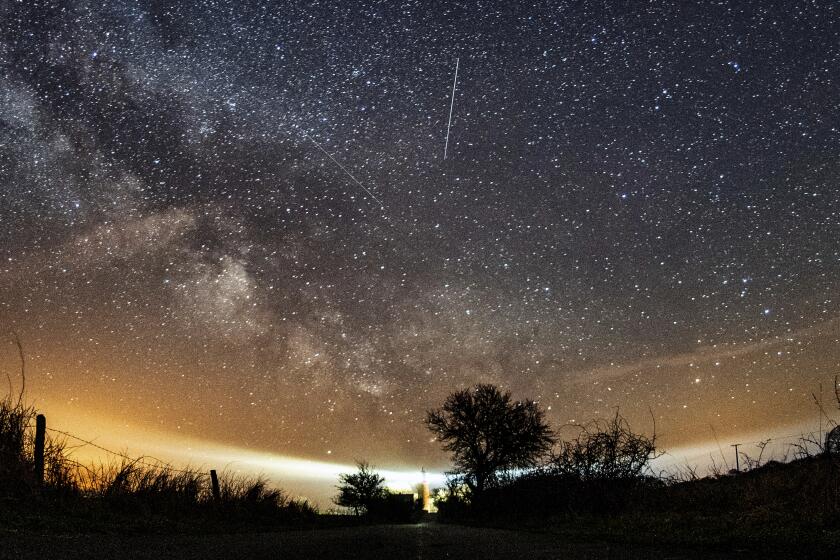Oceano Dunes’ unhappy campers
- Share via
OCEANO, CALIF. — For Byron Clayworth, it didn’t get much better than this: sipping a beer, camping on the beach with his buddies and their families, frying up dinner for 15 on a homemade wok, and, most of all, zooming around the dunes on an amazing variety of off-road vehicles.
That about 25,000 other people were enjoying the Oceano Dunes State Vehicular Recreation Area in much the same way this weekend was no big deal. Getting used to the constant background whine of engines is easy, Clayworth said, but getting used to the constant buzz of environmental activists -- that’s a different story.
“We’ve been squeezed too much already,” said Clayworth, 51, a mechanic at a Modesto dairy. “How much do they want?”
It’s a question on the minds of thousands of off-road enthusiasts as a crucial decision looms for the Oceano dunes -- one of the state parks’ busiest campsites and the last major place in California where driving on the beach is still legal.
Over the years, the off-roaders point out, the sand they have been allowed to whip across on everything from Model T Fords to hopped-up Hummers has, mostly for environmental reasons, been whittled from 15,000 acres to about 1,500. They fear that a decision Tuesday by the San Luis Obispo County Board of Supervisors could impose further restrictions on the site’s 2 million annual visitors.
Since 1983, the county has leased 584 acres to the park free of charge, most of it in prime riding terrain. With the 25-year operating agreement set to expire next year, the board is to decide whether to approve the state’s purchase offer of $4.8 million -- a choice as highly favored by the off-roaders as it is opposed by San Luis Obispo’s vocal environmental community.
“A sale to the state would be a huge mistake,” said Nell Langford, a retired psychology professor who owns a vacation rental home that looks out on the parade of cars, trucks and trailers hauling all-terrain vehicles down the beach. “Here’s a county that’s environmentally evolved, that’s into protecting its citizens from air pollution and all the things that ATV use generates. What are they thinking?”
Off-roaders want the sale approved, figuring a permanent transfer to the state would preserve the remaining riding territory. In their view, a return to county control would allow environmental activists to sway local political leaders and ultimately destroy a pastime that has been cherished for generations.
“There’s been motorized recreation on this beach for over 100 years,” said Jim Suty, head of the off-road advocacy group Friends of Oceano Dunes. “My parents used to race Jeeps here in the ‘60s, I’m enjoying it with my kids, and I want their kids to be able to enjoy it too.”
After years of conflict, both sides are highly organized. Suty’s group just held its annual crab feed, a fundraiser for its legal fees, in the Central Valley town of Hanford.
And Langford was organizing a pointed “Children’s Day” celebration, with playing tots encircled by a “human shield” protecting them from traffic on the beach.
Even with all the passion of the debate, neither side expects a sudden end to off-roading in the dunes -- permitted by the California Coastal Commission after the establishment of off-highway vehicle areas in 1982. But both sides are bracing for a fight over more restrictions.
For state parks ranger Will Pierce, the politics of it all took a back seat as he watched a gray sedan carving a serpentine track through the traffic on the hard-packed mud beside the sea.
“I’ve seen it a million times,” said Pierce, a beach ranger for eight years. “Ordinarily sensitive, nice, conservative people get behind the wheel here and suddenly it’s the Baja 500.”
Pierce had his hands full. One of 140 employees who work in the park at peak hours, he had spent his shift dealing with groups of rowdy college students, an alleged sexual assault, park restrooms stripped of toilet paper, and an empty 28-foot cabin cruiser that had broken loose of its moorings and smashed onto the beach.
He waved down speeders exceeding the 15 mph limit on the flats -- there is no limit on the dunes -- and warned parents who were illegally letting young children drive.
Cruising through the dunes in his truck as dirt bikes and quad-runners leaped skyward, he paused at a crest and looked down at the sprawling encampment several hundred feet below. In row after jagged row sat a thousand RVs and pickups and trailers, many with banners blowing in the wind -- Old Glory, the flag of Mexico, the Confederate flag, here a frosty beer mug, there a skull-and-crossbones.
In the 1930s, the dunes were home to a community of mystics who called themselves Dunites. Earlier, it was home to a failed subdivision that advertised itself as “the Atlantic City of the Pacific.” Now it’s home to big families of weekend warriors, many making the hours-long trek from the Central Valley with generators, gas grills and the latest in motorized fun.
“They just love it,” Pierce said. “It’s their Disneyland.”
For environmentalists, though, it’s not quite the happiest place on Earth. Each weekend, legions of trucks and trailers splash across the Arroyo Grande Creek -- a habitat for several rare species -- at both of the park’s entry points onto the beach. Dust whipped up by off-roaders pollutes the air in nearby communities, activists say, and protections afforded the Western snowy plover after a Sierra Club lawsuit over the threatened bird are inadequate, they add.
“It’s the local version of the spotted owl,” said Andrew Christie, a spokesman for the local Sierra Club chapter. “You can still find lots of ‘Run Over a Plover’ bumper stickers in Oceano.”
When the birds are nesting, park employees monitor their fenced-off, 300-acre patch of sand with binoculars, laying down driftwood and kelp to “artificially enhance the habitat,” said park Supt. Andrew Zilke.
The effort takes three full-time environmental scientists and 10 or 11 seasonal employees. Zilke, an advocate of the land sale, said he doubted that the county could go it alone.
But the sale’s opponents insist that the county, even if it negotiates a new lease with the state, exert more control over a precious natural resource.
In a letter to county supervisors, the Sierra Club likens selling the land to “selling Half Dome in Yosemite.” The more responsible course, the letter says, is to offer the state a lease with some tough conditions, such as building a less damaging park entry and permanently closing the 300 acres now fenced off for the plover and the least tern from March through September.
“Your whole focus should be on how your decision will help or harm this land in years to come,” the letter says.
That’s not quite on target for many local businesses, who say the focus should be on the money -- about $200 million annually, by state estimates -- that off-roaders leave behind.
“If the environmentalists have anything to do with it, there’ll be complete devastation,” said John Aitkens, who has run B.J.’s ATV Rentals since 1982. Off-roaders “spend on fuel, on groceries, on hopping down to the outlet mall in Pismo Beach. They close the beach and you’ll see people all around there going broke.”
The arguments over the dunes will continue after Tuesday’s hearing, almost certainly up to the Coastal Commission and perhaps to the courts. Among the issues to be settled is a basic one: Did the commission OK off-roading on the beach decades ago despite a county plan forbidding it?
But to Clayworth, the Modesto dairy mechanic, the reality of the dunes was far different. Later on, he and his friends would build a big bonfire. As happily exhausted as skiers after a day of schussing, the children would roast marshmallows and have a great time. They wouldn’t have the pay-per-view setup they had a few months ago that drew other campers for a televised kickboxing tournament, but it would be great anyway.
“Where else can you go and ride quads on the beach with the whole family for $10 a night?”
*
More to Read
Sign up for The Wild
We’ll help you find the best places to hike, bike and run, as well as the perfect silent spots for meditation and yoga.
You may occasionally receive promotional content from the Los Angeles Times.







